Diu is indeed considered a worthwhile travel destination, particularly if you are seeking a beach vacation near Gujarat. It offers a unique blend of sun, sand, and history, making it an appealing escape from the everyday hustle. Many travellers find Diu an unspoilt beach destination with a quaint, old-world charm, featuring pristine beaches and beautiful buildings.
Here are some key reasons why Diu might be worth your visit:
- Clean and Serene Environment: Diu is noted for its unpolluted streets, clean sea water suitable for bathing, and well-maintained memorials. Beaches like Nagoa and Ghoghla are described as comparatively clean and clear, with blue waters and sand that can “steal your heart”.
- Historical and Cultural Richness: Once a Portuguese colony for 450 years, Diu boasts a multi-faced cultural heritage blending tribal, Indian, Portuguese, and European influences. You can explore significant historical landmarks such as the imposing Diu Fort and intricate churches like St. Paul’s Church.
- Affordability: Diu is highlighted as being cheaper than Goa for seafood, water sports, and local transport, making a beach vacation here affordable for various budgets.
- Unique Experiences: The island hosts Asia’s longest beach festival, Fiesta De Diu, a 70-day event near Nagoa beach that includes luxury tents, live music, and adventure sports.
While some visitors note a limited number of attractions and activities compared to other destinations, Diu’s appeal lies in its relaxed atmosphere and historical depth. For a comprehensive understanding of what Diu offers, from its delightful food options and recommended stays to a detailed exploration of its attractions and travel tips, continue reading for more in-depth information.
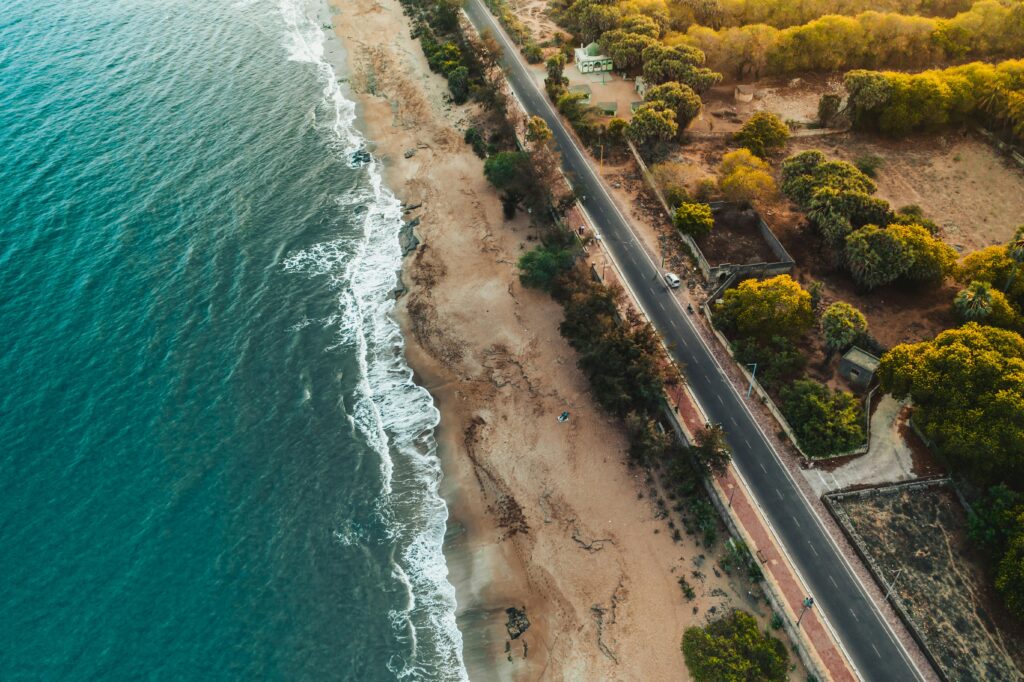
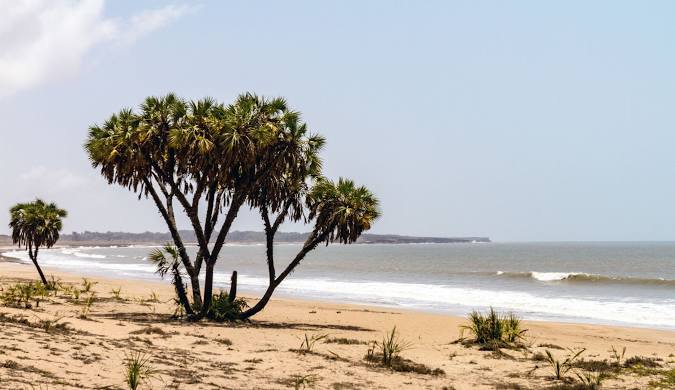
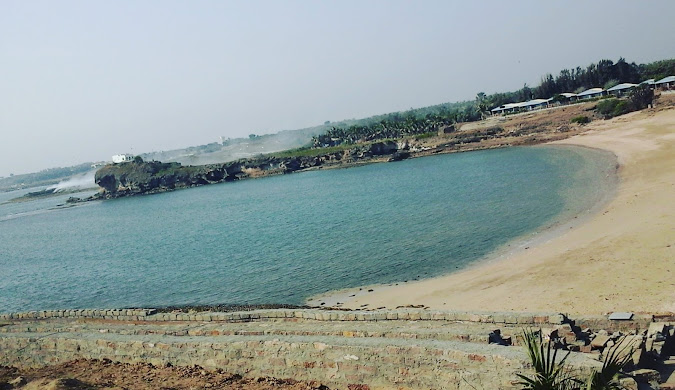
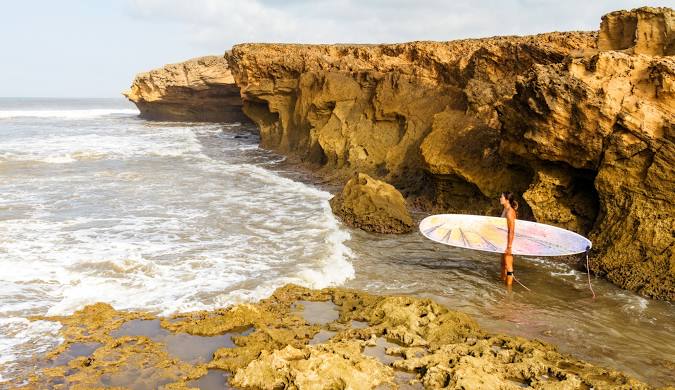
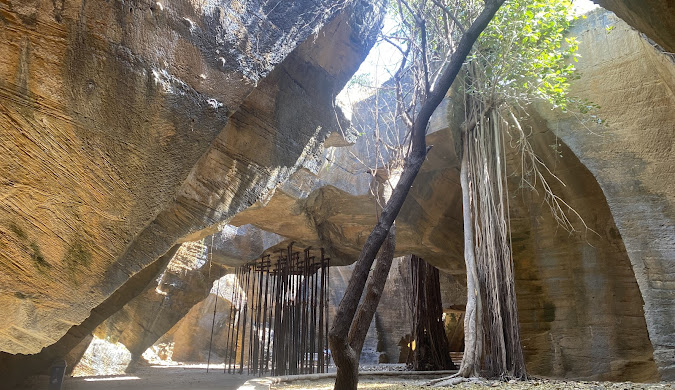
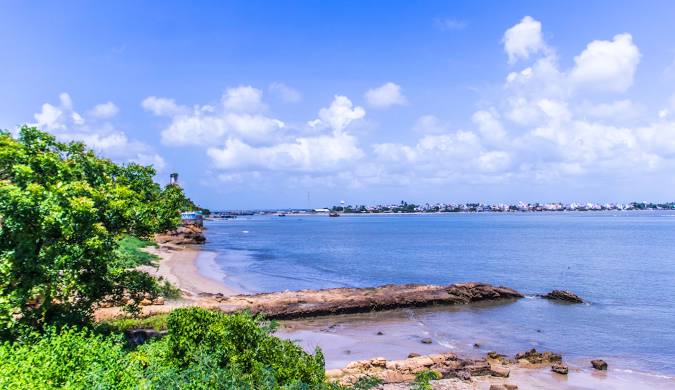
I. Introduction: Diu’s Allure as a Unique Indian Destination
Diu is a captivating blend of sun, sand, and history, offering an escape from the chaos of daily life. This small island city, part of the union territory of Dadra and Nagar Haveli and Daman and Diu, is dotted with pristine beaches and showcases a rich heritage alongside exquisite architecture. It serves as one of the best beach vacation destinations near Gujarat and is a favoured tourist spot for beach lovers.
Diu is notably famous for its pristine beaches, a profound Portuguese colonial heritage, an unpolluted and tranquil environment, and a laid-back charm that distinguishes it from more crowded destinations such as Goa. This unique blend makes it an ideal vacation destination for those seeking relaxation, historical exploration, and natural beauty near Gujarat.
II. Diu’s Famous Beaches: Sun, Sand, and Serenity
Diu is renowned for its clean and clear waters and unsoiled sea, making it suitable for bathing. The blue waters with waves and sand are particularly captivating, capable of holding one’s attention for hours.
- Nagoa Beach: Considered one of the most scenic beaches in India, Nagoa Beach is praised for its pristine beauty and outstanding surroundings. Its distinct crescent shape, resembling a serpent, adds to its allure. It is an ideal spot for enjoying warm sand and refreshing sunrises or sunsets. Nagoa Beach offers various water sports, including parasailing, jet skiing, and water boat rides, all available at affordable costs. It is located in the hamlet of Nagoa in the village of Bucharwada.
- Ghoghla Beach: As the largest beach at the northern tip of Diu, Ghoghla Beach provides panoramic views of the Arabian Sea. It is comparatively clean, clear, and less crowded than some alternatives, making it ideal for solitude seekers. This beach also offers water sports facilities, such as parasailing, for adventure enthusiasts. Historically, Portuguese ships were said to anchor here and watch the sunset from their decks.
- Jallandhar Beach: This is a stunning and untouched beach in Diu, known for its tranquil and pure water. It is named after the Demon Jallandar, with a small dedicatory shrine encompassing a stone bearing the demon’s face located nearby. It’s recommended for those seeking a calm and clean beach experience.
- Chakratirth Beach: A rocky beach, Chakratirth offers tranquillity and has a legendary connection to Lord Krishna’s fight with the demon Jalandhar. It tends to be crowded, attracting both domestic and international tourists.
- Gomtimata Beach: Another of Diu’s famous beaches.
Beyond water sports, Diu’s beaches are perfect for long walks, watching spectacular sunsets, and luxuriating on golden sands. Other beach activities like camel rides and horse rides are also available.
III. Diu’s Historical and Architectural Grandeur
Diu’s identity is inextricably linked to its past as a Portuguese colony from 1535 until 1961. This long colonial period resulted in a distinctive multi-faced cultural heritage and significantly transformed the city’s architectural profile, introducing European amenities like churches and civic buildings into the urban landscape.
- Diu Fort: The Diu Fort is celebrated as the most beautiful historical building and a top tourist attraction in Diu, making it a must-visit. Built in 1535 and strengthened until 1546, it played a crucial role in defence alliances, particularly against the Mughal Emperor Humayun. Administered by the Government of India, the fort offers mesmerising views of the sea. Inside its massive ramparts, visitors can find multiple chapels, barracks, a granary, a jail complex, and a lighthouse which is the highest point in Diu, with a beam reaching 32 km in every direction. Cannonballs litter the grounds, and a series of cannons line the ramparts. The fort has withstood countless battles and bears witness to pivotal historical moments, including the end of Portuguese rule in 1961.
- St. Paul’s Church: This magnificent building of Gothic architecture was constructed by the Portuguese between 1601 and 1610. Dedicated to Our Lady of Immaculate Conception, its main façade is considered one of the most elaborate among Portuguese churches in India. The church is adorned with intricate wood carvings and shell-like motifs, believed to merge with the abundance of shells on Diu’s shores. It also served as a seminary where Arabic was taught to students preparing to work in Akbar’s Court.
- St. Thomas Church: Built in 1598, this Gothic edifice now functions as a museum, housing antique statues, stone inscriptions, wooden carvings, and idols dating back to the 16th century and beyond. Historically, a part of it also served as a prison for Indian freedom fighters.
- Church of St. Francis of Assisi: Constructed in 1593, this is one of the oldest churches in Diu, now converted into a hospital. It boasts a colossal structure overlooking the Arabian Sea and features a carved wooden altar with images of the Holy Virgin.
- Naida Caves: These are man-made rock formations, believed to have been created when the Portuguese cut rocks for the construction of Diu Fort. These labyrinthine caves offer a maze-like network of tunnels and are a popular spot for photography. The caves are famously known as a filming location for Hrithik Roshan’s movie ‘Agneepath’. However, it is noted that the Naida Caves are currently closed for the foreseeable future.
- INS Khukri Memorial: This is a poignant tribute to 18 officers and 176 sailors who sacrificed their lives during the 1971 India-Pakistan war when the Indian naval ship INS Khukri sank off the coast of Diu. A scaled model of the INS Khukri is encased in a glass house at the memorial.
- Zampa Gateway: A major historical landmark, the Zampa Gateway is painted a vibrant red and serves as the key town entrance on the western side of Diu. It features engravings of devoted angels, lions, and a priest, and includes a sanctuary with an image of the Virgin and Child dating from 1702. A non-natural waterfall enhances its beauty.
- Fortim do Mar (Pani Kotha): This is a stone structure located in the sea, approximately one nautical mile (1.852 km) from the Diu jetty. Also known as ‘Sea Fort’ in English, it features a lighthouse and a small chapel dedicated to Our Lady of the Sea. Visitors can cruise on a motorboat to reach this majestic sentinel.
IV. Cultural Melting Pot and Culinary Delights
Diu boasts a multi-faced cultural heritage, reflecting an unusual amalgam of tribal, Indian, Portuguese, and European influences. The local inhabitants share similar traditions and customs with the people and culture of Gujarat.
- Festivals and Events:
- Fiesta De Diu: Asia’s longest beach festival, this 70-day event takes place near Nagoa beach. The festival compound features luxury tents, live music recitals, workshops, a small flea market, and adventure sports.
- Garba Festival: Given its proximity to Gujarat’s culture, the main festival in Diu is the Garba festival, dedicated to Goddess Durga and lasting nine days.
- Folk Dance Festival: An important festival featuring vibrant traditional folk dances performed by local men and women.
- Songkran (Thai New Year) and Loi Krathong (festival of flowers and lights) are also listed among the festivals and events for Diu, with dates in April and November respectively.
- Gastronomic Experiences: Diu’s food is an eclectic blend of Gujarati and Portuguese cuisine, with hints of African, Arabian, and Indian culinary traditions.
- Seafood: Given the fresh catches from the surrounding waters, seafood items like prawns, pomfret, and bangda fish are very popular and widely available. Restaurants generally maintain hygiene standards.
- Local and Indian Dishes: Visitors can try local items such as rotla (a flatbread) with vegetable or fish curry. Gujarati and Punjabi food like poori-aloo, chhole-bhature, and kingfish with rice and saag are also popular.
- Portuguese Delicacies: Sample dishes such as Penn de calamari (pasta with squid), Caldinho de Camarao (shrimp soup), and Cozido de pixie (fish stew).
- Alcohol: Diu is known for its affordable alcoholic drinks, which are a significant draw for many visitors, as alcohol is only served in Daman and Diu within Gujarat.
- While some dining experiences are highly rated, one traveller noted a scarcity of appealing dining options and inconsistent quality at certain establishments.
- Shopping: Visitors can find unique souvenirs and items, including decorative pieces made of seashells, tortoise shells, pearls, and bamboo. Colourful plastic bangles are also popular buys from shops and street stalls. Additionally, dry fruits (plain, salted, or roasted) are available, and cheap foreign goods can sometimes be found at licensed shops.
V. Diu’s Natural Environment and Unique Appeal
Diu stands out as one of the freshest Indian towns you would ever visit. Its streets are described as being in apple-pie order, the sea water is unsoiled and suitable for bathing, and its memorials are well-ordered. This notable cleanliness is partly attributed to its sparse population, as many families have moved out for better career opportunities, leaving behind a sparkling, picturesque port town for visitors.
Diu offers a quaint, old-world charm and is an unspoilt beach destination for relaxation-seekers looking to avoid thronging crowds. It promises a serene paradise experience, inviting visitors to explore, reflect, and rejuvenate amidst its sun-drenched beaches and historical monuments.
- Gangeshwar Temple: This spiritual site is dedicated to Lord Shiva, but its unique allure lies in its location. During high tide, five sacred Shiv Lingas positioned beneath a huge rock are immersed in sea water, offering devotees an inconceivable experience. It is believed that the Pandavas worshipped these Shiv Lingas during their exile.
- Jallandhar Shrine: Perched atop a hill, the Jallandhar Shrine offers panoramic views of the surrounding landscape. It symbolises the victory of good over evil and is devoted to Lord Shiva’s slaying of the demon king Jallandhar, who is believed to have been buried near the spot.
VI. Practical Information for Planning Your Trip
- Best Time to Visit: The winter season (October to February/March) is considered the peak and ideal time to visit Diu. During these months, the weather features warm afternoons and pleasantly cold evenings, with average temperatures ranging between 15-23°C, perfect for exploring beaches and engaging in water sports. The moderate season (March-May) sees higher temperatures but with a cool sea breeze.
- How to Reach:
- By Air: Diu has a domestic airport (DIU) at Nagoa, with daily flights connecting it to Mumbai and Porbandar. A chopper service also operates from Daman to Diu.
- By Train: The most convenient nearest railway junction is Veraval, located about 90 km from Diu. Veraval is connected to major cities like Mumbai, Ahmedabad, Pune, Jabalpur (Madhya Pradesh), Dwarka, and Thiruvananthapuram. Delvada, a meter gauge station, is closer at 8 km from Diu, with two daily trains connecting it to Junagadh and Veraval.
- By Road: Diu is well-connected by roads to major cities in Gujarat and Maharashtra, including links to major National Highways. State and private buses are available from cities such as Mumbai, Ahmedabad, Rajkot, Surat, Vadodara, and Bhavnagar.
- Local Transport: Within the town, local buses, auto-rickshaws, and rented bikes are convenient options for getting around. Walking is also a viable transport option between attractions. However, some sources note a lack of a well-developed and organised local internal transport system as a weakness.
- Accommodation: Diu offers a range of stays, including hotels and resorts, with varying price points. Recommended options include The Grand Highness, which provides comfortable accommodation, even presidential suites with sea views. Other options like Hotel Apaar, Azzaro Resort & Spa, Ginger Diu, Praveg Beach Resort, The Fort House, and The Fern Seaside Luxurious Tent Resort are also available. One traveller noted difficulty finding suitable Airbnb options and the presence of fake reviews for some hotels, suggesting personal inspection upon arrival.
VII. Diu’s Comparative Advantage and Future Potential
Diu presents itself as a compelling alternative to more popular beach destinations. It is noted to be cheaper than Goa, with better prices for seafood, water sports, and local transport.
- Proximity: Its proximity to Mumbai, one of India’s largest gateways for international tourists, and other industrial towns in Maharashtra and Gujarat, offers significant opportunities for tourism growth. Diu is also one of the closest beach destinations for central and northeastern parts of India, such as Madhya Pradesh, Rajasthan, and Uttar Pradesh.
- Development Potential: Diu has been declared a Special Tourism Area for both domestic and international marketing. There is strong potential for it to be developed as a world-class “Island Destination” and a “Serene Paradise,” with tourism positioned for “Beach and Island Experience”. The government is making efforts to promote it as a sought-after beach destination suitable for various occasions, including parties, business meetings, wedding destinations, and historical tourism focused on its ancient churches. There is potential for Diu to be part of a tourism circuit including Veraval, Somnath, and Sasangir.
- Challenges: Despite its strengths, Diu faces certain challenges. These include a lack of well-developed internal transport facilities and concerns regarding the inadequate or ill-managed conservation of some heritage monuments (though the fort is commendably maintained). There is also a noted fading of Portuguese culture as people move away in search of better career opportunities. One traveller also expressed disappointment with the perceived limited activities and dining options. Furthermore, there’s a lack of awareness of Diu as a destination and improper market positioning.
VIII. Conclusion: Is Diu Worth Visiting?
Diu is undeniably famous for its fascinating combination of history, sand, sun, and architecture, enticing visitors looking for a perfect escape. It is well-regarded for its historical significance as a former Portuguese colony, its array of clean and beautiful beaches, its unique blend of cultures and cuisines, and its tranquil atmosphere that provides a refreshing escape from the chaos of daily life.
While some aspects like local transport and certain dining experiences could be improved, Diu’s distinct charm, affordability, and historical depth make it a compelling destination. It is described as a “well-kept secret among travellers looking for relaxing, unpolluted places“. For those seeking a tranquil vacation, cultural immersion, and a break from the ordinary, Diu offers a worthwhile and unique travel experience.
Table of Clarity: Diu Travel Guide
| Category | Details |
|---|---|
| Destination | Diu, Union Territory of Dadra & Nagar Haveli and Daman & Diu, India |
| Famous For | Pristine beaches, Portuguese colonial heritage, historical forts & churches, affordable seafood & alcohol, serene charm |
| Top Beaches | Nagoa Beach (water sports, crescent shape), Ghoghla Beach (largest, clean & less crowded), Jallandhar Beach (calm, demon shrine), Chakratirth Beach (mythological, rocky), Gomtimata Beach |
| Major Attractions | Diu Fort, St. Paul’s Church, St. Thomas Church (Museum), Church of St. Francis, Naida Caves, INS Khukri Memorial, Zampa Gateway, Fortim do Mar (Pani Kotha), Gangeshwar Temple, Jallandhar Shrine |
| Unique Events | Fiesta De Diu (Asia’s longest beach festival, 70 days), Garba Festival, Folk Dance Festival, Thai Festivals (Songkran, Loi Krathong) |
| Food Specialties | Fresh seafood (prawns, pomfret, bangda), Portuguese dishes (Caldinho de Camarao, Cozido de pixie), Gujarati/Indian staples (rotla, chhole-bhature), affordable alcohol |
| Shopping | Seashell & bamboo handicrafts, pearl jewelry, colorful bangles, dry fruits, imported goods |
| Best Time to Visit | October – February (cool & pleasant, 15-23°C). March – May (warmer but breezy). Avoid monsoon for beach activities. |
| How to Reach | Air: Diu Airport (DIU) – flights from Mumbai & Porbandar. Rail: Nearest major station – Veraval (90 km). Road: Connected via highways to Mumbai, Ahmedabad, Rajkot, Surat, Vadodara. Local: Auto-rickshaws, buses, bike rentals (limited public transport). |
| Accommodation | Ranges from budget hotels to luxury resorts: The Grand Highness, Azzaro Resort & Spa, Ginger Diu, The Fern Seaside Tent Resort |
| Affordability | Cheaper than Goa (seafood, water sports, alcohol, transport). Budget-friendly destination |
| Safety | Generally safe; peaceful town with low crime. Some concerns about monument conservation & limited activities |
| Ideal For | Beach lovers, history buffs, culture explorers, family trips, budget travelers, offbeat explorers |
| Comparative Advantage | Less crowded & cheaper than Goa, rich Portuguese history, proximity to Gujarat & Maharashtra, declared a “Special Tourism Area” |
Frequently Asked Questions about Diu
1. What is Diu and where is it located?
Diu is a small island city situated off the southern coast of Gujarat’s Kathiawar peninsula in India. It is separated from the mainland by a tidal creek. Diu is part of the Union Territory of Dadra and Nagar Haveli and Daman and Diu.
Historically, Diu flourished as a major port of the Gujarati state from the 15th century and became the seat of the governors of Surat. It was under Portuguese control from 1535 until 1961, significantly influencing its culture, architecture, and urban landscape. The island spans approximately 38 km² (15 sq mi) and had a population of 44,110 as per the 2001 census.
2. What are the main attractions and things to do in Diu?
Diu offers a blend of historical sites, pristine beaches, and cultural experiences. Key attractions and activities include:
- Diu Fort: A massive 16th-century Portuguese fort built in 1535 and strengthened until 1546. It offers panoramic sea views and houses chapels, barracks, a granary, a lighthouse, and a jail complex.
- Beaches:
- Nagoa Beach: Known for its pristine beauty, crescent shape resembling a serpent, and various water sports facilities like parasailing, jet skiing, and water boats.
- Ghoghla Beach: The largest beach in Diu, offering panoramic views of the Arabian Sea and water sports.
- Jallandhar Beach: A stunning and untouched beach named after the Demon Jallandar, offering tranquility and pure water. A small dedicatory shrine is located nearby.
- Chakratirth Beach: A rocky and serene spot with a legendary connection to Lord Krishna.
- Gomtimata Beach: Another famous beach.
- Churches:
- St. Paul’s Church: Also known as the Church of Immaculate Conception, built from 1601 to 1610. It is a magnificent Gothic architectural masterpiece with intricate wood carvings, considered one of the most elaborate Portuguese churches in India.
- St. Thomas Church: Built in 1598, it now functions as a museum displaying antique statues, stone inscriptions, and wooden carvings.
- Church of St. Francis of Assisi: Constructed in 1593, it is one of the oldest churches, now transformed into a hospital. It boasts a colossal structure and overlooks the Arabian Sea.
- Naida Caves: A fascinating network of man-made tunnels and caves believed to have been formed by the Portuguese extracting rocks for the fort. It’s a popular spot for photography in the morning. Note: One recent account states Naida Caves are currently closed for the foreseeable future, though other sources list them as attractions.
- INS Khukri Memorial: A poignant tribute to the brave Indian naval soldiers who lost their lives during the 1971 Indo-Pak war, featuring a scaled model of the sunken ship.
- Zampa Gateway: A vibrant red, intricately carved historical entrance to the town, adorned with angels, lions, and a priest, and enhanced by a non-natural waterfall.
- Gangeshwar Temple: Dedicated to Lord Shiva, known for its unique location where five Shiv Lingas are immersed in sea water during high tide.
- Fortim do Mar (Pani-Kotha): A stone structure built in the sea at the mouth of the creek, approximately one nautical mile from Diu jetty, featuring a lighthouse and a small chapel.
- Fiesta De Diu: Asia’s longest beach festival, a 70-day event near Nagoa beach featuring luxury tents, live music, workshops, a market, and adventure sports.
- Other Activities: Exploring the city on a bicycle to discover Portuguese-influenced cuisine, shopping for local souvenirs like shell crafts, plastic bangles, pearls, dry fruits, and inexpensive alcoholic beverages.
3. When is the best time to visit Diu?
The ideal time to visit Diu is during the winter season, from October to March.
- Peak Season (October to February/March): The weather is pleasant, with warm afternoons and pleasantly cold evenings. Temperatures typically range from 15-23°C. This period is considered the best for exploring beaches and engaging in outdoor activities.
- Moderate Season (March, April, May): Characterised by high temperatures with a cool sea breeze. This shoulder season sees fewer crowds, and offers opportunities for thrilling water sports and hotel deals.
- Off-season/Low Season (June to September): Experiences heavy showers alternating with a humid atmosphere. This period has the fewest crowds.
- Festivals: Festivals like Songkran (Thai New Year) from April 13-15 and Loi Krathong (festival of flowers and lights) in November attract a large number of tourists.
4. How can one get to Diu?
Diu is accessible by air, train, and road.
- By Air: Diu has a domestic airport (Diu Airport, DIU), with daily flights connecting to Mumbai and Porbandar. Connecting flights are also available from other cities like Ahmedabad and Surat. A chopper service operates from Daman to Diu.
- By Train: The nearest railway junction is Veraval, approximately 90 km away, which is well-connected to major Indian cities like Mumbai, Ahmedabad, Pune, and Thiruvananthapuram. A closer meter-gauge station, Delvada, is just 8-10 km from Diu, with daily trains connecting Junagadh and Veraval.
- By Road: Diu has a good road network and is well-connected to cities in Gujarat and Maharashtra. State and private buses operate from various cities, including Mumbai, Ahmedabad, Rajkot, Surat, Vadodara, and Bhavnagar.
- Within Diu: Local buses, rickshaws, and rented bikes are convenient transport options for hopping between attractions.
5. What is the cultural heritage of Diu?
Diu boasts a rich and multifaceted cultural heritage, shaped by an unusual amalgam of tribal, Indian, Portuguese, and European influences.
- People: The local population’s customs and traditions closely resemble those of Gujarat.
- Religion and Language: The three major religions are Hinduism (forming the majority), Islam, and Christianity. The main languages spoken are Gujarati and Hindi.
- Festivals: Reflecting its proximity to Gujarat’s culture, the main festival is the Garba festival, dedicated to Goddess Durga and stretching for nine days. The Folk Dance Festival also features vibrant traditional performances. Other festivals include Fiesta De Diu and the Kite Festival.
- Portuguese Legacy: The enduring Portuguese legacy is evident in the city’s architecture, particularly its churches and forts, and its local cuisine, which features a fusion of Indian and Portuguese flavours, especially seafood. However, the Portuguese culture is noted to be fading as many families have moved out of the country for better career opportunities.
6. What unique culinary experiences can one find in Diu?
Diu’s cuisine is a delightful fusion, primarily influenced by Gujarati and Portuguese culinary traditions, with hints of African, Arabian, and other Indian flavours.
- Seafood: Given its coastal location, fresh seafood is a highlight, with popular dishes including prawns, prom fret, kingfish, prawn curry, and fried bangda fish.
- Vegetarian Options: For vegetarians, Gujarati dishes and local vegetable preparations with aromatic spices are available.
- Portuguese Delicacies: Visitors can try unique Portuguese dishes such as “Penn de calamari” (pasta with squid), “Caldinho de Camarao” (shrimp soup), and “Cozido de pixie” (fish stew).
- Local Food: Other local items include rotla (a kind of flatbread) with vegetable/fish curry, poori-aloo, chhole-bhature, and saag.
- Beverages: Alcoholic beverages are readily available and generally cheaper than in Goa, contributing to its appeal for some tourists. Restaurants in Diu are generally noted for serving food with hygiene standards.
7. How does Diu compare to Goa as a beach vacation destination?
Diu is often presented as a compelling alternative to Goa for beach vacations, offering a distinct experience.
- Cleanliness: Diu’s Nagoa and Ghoghla beaches are described as comparatively cleaner and clearer than some of Goa’s northern beaches, which have become “unclean” and less suitable for surfing and bathing.
- Affordability: Diu is generally considered cheaper than Goa, especially for seafood, water sports, and local transport, making it an affordable destination for various budgets.
- Crowd Levels: Diu is less explored by many travellers, offering a more tranquil and less crowded experience compared to the bustling beaches of Goa.
- Atmosphere: While Goa is known for its party scene, Diu offers a more relaxed pace, quiet relaxation, unpolluted environments, and a historical charm.
- Activities: While some sources highlight a range of activities including water sports, historical sites, and festivals, a recent visitor noted a dearth of things to do beyond drinking, suggesting only half a day is needed to see everything.
8. What are the challenges and opportunities for tourism development in Diu?
A SWOT analysis highlights several aspects for Diu’s tourism industry:
- Strengths:
- Pristine natural beauty and clean beaches (Nagoa, Ghoghla, Chakratirth, Jallandhar, Gomtimata).
- Rich historical heritage with enticing monuments and forts (Diu Fort, Fortim do Mar).
- Developed value-for-money accommodation facilities.
- Pollution-free tourism zones.
- Unique Portuguese cultural influence.
- Weaknesses:
- Lack of a well-developed and organised internal transport system.
- Inadequate conservation and management of some heritage monuments, leading to tourist dissatisfaction.
- Fading Portuguese culture as locals seek better opportunities elsewhere.
- Limited number of tour operators.
- Lack of awareness about the destination and improper market positioning.
- Limited activities for tourists beyond drinking, according to some recent accounts.
- Opportunities:
- Proximity to major Indian cities like Mumbai, Ahmedabad, and other industrial towns in Maharashtra and Gujarat.
- Potential to attract tourists from central and northeastern parts of India as a close beach destination.
- Can be developed as part of a tourism circuit with nearby attractions like Veraval, Somnath, and Gir National Park.
- Diu has been declared a Special Tourism Area for domestic and international marketing.
- Threats:
- Unorganised and unplanned exploitation of tourism potential.
- Local mindset sometimes looks down upon working in unskilled hotel roles.
- Decline in Western and North American tourist numbers.
- CRZ (Coastal Regulation Zone) regulations may hamper beach development.
To enhance tourism, there is a need for government investment in infrastructure, improved transport, better monument conservation, and marketing to promote Diu’s unique cross-cultural fusion and varied attractions beyond just alcohol. Training local people to participate responsibly in the tourism industry can also create employment opportunities.
9. Is Diu worth visiting for a vacation?
Diu is generally considered a worthwhile destination for those seeking a tranquil, unpolluted, and historically rich beach vacation. It is particularly appealing for beach lovers and offers a relaxed alternative to more crowded destinations like Goa.
It can be explored in 2-3 days to experience its main attractions and is considered a perfect destination for family vacations. Its unique blend of history, sand, sun, and architecture makes it enticing for visitors looking for an escape.
However, some recent visitor experiences suggest that there are limited activities beyond drinking alcohol. One traveller found it possible to see everything in Diu within half a day and noted a general lack of diverse attractions, leading to boredom. This suggests that Diu’s appeal can be subjective, depending on a traveller’s interests and expectations.
- Kaas Plateau Travel Guide 2026: Best Time to Visit, Bloom Season, How to Reach & FAQs
- What Is the Quirimbas Archipelago Mozambique Known For? Complete Travel & Nature Guide
- Is Angola Safe to Travel in 2025? Your Essential Guide to Health, Crime, and Landmine Safety
- What Animals Live in Bale Mountains Ethiopia? Complete Wildlife Guide
- What to Do in Damaraland — Complete Travel Guide for First-Timers
